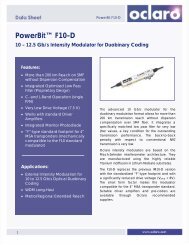PowerBit™ SD-40 40 Gb/s Intensity Modulator
PowerBit™ SD-40 40 Gb/s Intensity Modulator
PowerBit™ SD-40 40 Gb/s Intensity Modulator
Create successful ePaper yourself
Turn your PDF publications into a flip-book with our unique Google optimized e-Paper software.
PowerPort TM 20<strong>40</strong>/21<strong>40</strong> TRX<br />
10 <strong>Gb</strong>/s XFP Transceiver for <strong>40</strong>km TDM & DWDM Applications<br />
DIGITAL DIAGNOSTIC FUNCTIONS<br />
The Avanex XFP module provides a management interface as described in the XFP standard (MSA Rev 4.5). There are<br />
3 control input signals, 3 status output signals, and a 2-wire serial interface. The signals are described in section 2.4 of the<br />
XFP standard. The control signals allow the module to be placed in a low-power state, to be reset, to enable/disable the<br />
serial interface, and to turn-off the transmitter. The status signals indicate loss of received signal, detection of an invalid<br />
condition, and the presence of additional status information via the serial interface.<br />
The serial interface provides access to the more detailed identification and diagnostic monitoring information. It provides<br />
access to a 256-byte register space. This interface runs at up to <strong>40</strong>0 kHz (with occasional clock stretching not exceeding<br />
500µs), and the module supports a packet error checking protocol to verify transfer integrity. Full details are described in<br />
chapter 4 of the XFP standard.<br />
The register space is divided into upper and lower 128-byte spaces, as described in chapter 5 of the standard. The lower<br />
128-bytes provides access to the more frequently accessed information, including readout of optical signal and laser<br />
levels, alarm and warning flags, and read/write of control and status signals. The upper 128-bytes contain one of a<br />
number of pages of information. The desired page is selected by writing a byte in the lower 128-half. Page 1 contains<br />
extended module identification information, and page 2 provides a space of 128-bytes of non-volatile storage for the host<br />
system.<br />
In order to accommodate the signal conditioner device used in our XFP module, the host system shall inform the XFP<br />
module of the data rate. The data rate is written into the upper 4 bits [7-4] of Byte 01h. The value to be entered is given<br />
by:<br />
Byte 01h [bits 7-4] = INT(Data rate[<strong>Gb</strong>ps) – 9.5 ) /0.2))<br />
Table below gives Byte 01h [bits 7-4] depending on the data rate used:<br />
AFR20<strong>40</strong><strong>40</strong>8<br />
Error Correcting Capapility<br />
Percentage<br />
Bandwidth<br />
Expansion Data Rate<br />
Required<br />
REFCLK<br />
Frequency<br />
Byte<br />
01h[bits7-4]<br />
STS-192, 0 bytes 0% 9.953 <strong>Gb</strong>ps 155.52 MHz 0010xxxx<br />
10 Gigabit Ethernet 0% 10 <strong>Gb</strong>ps 156.25 MHz 0010xxxx<br />
10 Gigabit Ethernet 64/66B<br />
encoded 3,125% 10.3125 <strong>Gb</strong>ps 161.13 MHz 0100xxxx<br />
10 G Fiber Channel 0% 10.5187 <strong>Gb</strong>ps 164.35 MHz 0101xxxx<br />
STS-192, Reed Solomon -<br />
255/238 7,14% 10.66 <strong>Gb</strong>ps 166.63 MHz 0101xxxx<br />
STS-192, Reed Solomon -<br />
255/237 7,59% 10.709 <strong>Gb</strong>ps 167.33 MHz 0110xxxx<br />
10 Gigabit Ethernet 64/66B<br />
encoded - 255/238 7,14% 11.0491 <strong>Gb</strong>ps 172.642 MHz 0111xxxx<br />
g<br />
encoded - 255/237 7,59% 11.0957 <strong>Gb</strong>ps 173.37 MHz 0111xxxx<br />
10 G Fiber Channel, Reed<br />
Solomon -255/238 7,14% 11.27 <strong>Gb</strong>ps 176.095 MHz 1000xxxx<br />
10 G Fiber Channel, Reed<br />
Solomon -255/237 7,59% 11.318 <strong>Gb</strong>ps 176.84 MHz 1001xxxx<br />
4



